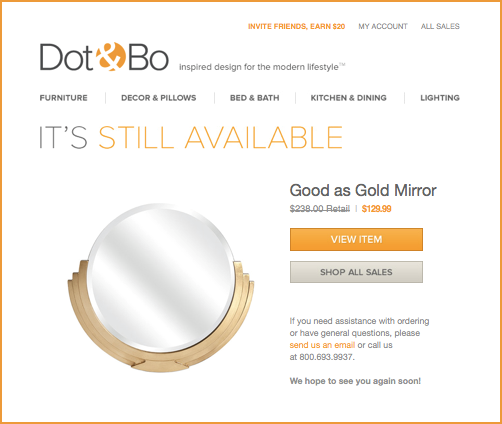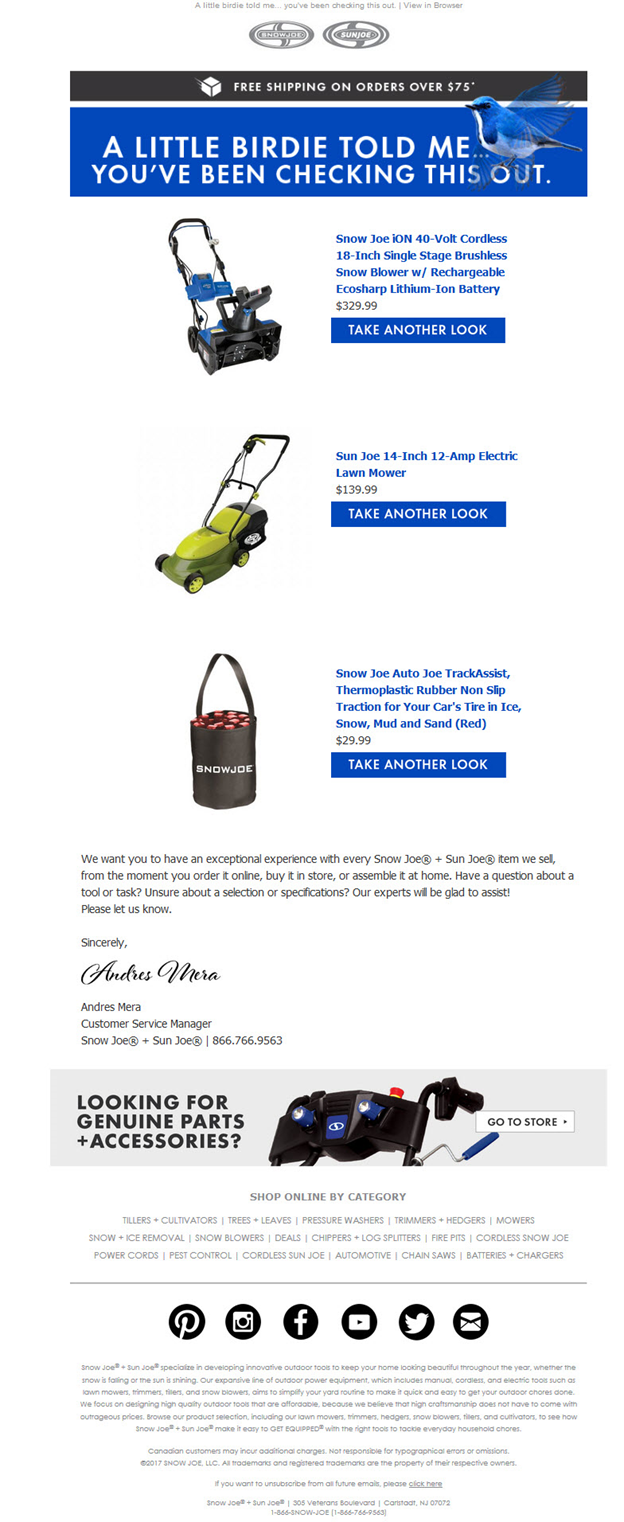How to Design a Cart Abandonment Email Campaign Strategy
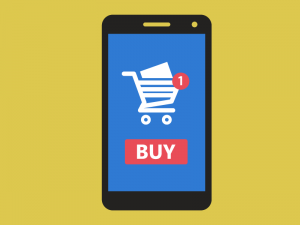 Are you tracking your visitor’s behavior that browse your products and services but are not ready to put into a cart or purchase? Some just need a nudge, a friendly reminder, or perhaps a small incentive to make the jump off the virtual shelf and into a cart. And when partnered with a cart abandonment program, there is money to be added to your bottom line.
Are you tracking your visitor’s behavior that browse your products and services but are not ready to put into a cart or purchase? Some just need a nudge, a friendly reminder, or perhaps a small incentive to make the jump off the virtual shelf and into a cart. And when partnered with a cart abandonment program, there is money to be added to your bottom line.
Browse abandonment automated emails will improve web site conversion rates for e-commerce, lead- generation, nonprofits, event planners, and other websites.
What is Browse Abandonment?
Consider window shoppers who never make it to the register or did not even put the items in their cart but expressed interest. Some may have picked up a product, read the label, or even tried it on. But then they’re gone, often before you had a chance to strike up a conversation.
Website browsers can be easy to reengage, even after they’ve left – if you have a few things in place. First, you need to be collecting visitors’ email address (and opt in). This is easily done if your website requires a login or registration or if the visitor signed up to your email campaigns.
Next, choose a browse abandonment platform (i.e. LassoBack) that will track the behavior of your website visitors and determine if they are buying or just browsing. Each type of behavior comes with its own marketing plan.
Who and What are Browse Abandoners?
There is no explicit answer. It’s up to you to determine who your abandoners are and what action(s) potential purchasers might take while viewing your website.
As with any digital and email marketing, you need to understand who you’re communicating with. Take into account who your site visitors are. For a typical browse abandonment campaign, you’re talking to visitors at the beginning of the sales process. They might be defined as:
- Visitors who have gone beyond the home page
- Visitors who have viewed specific product or service pages
- Visitors that have not added anything to their cart
- Visitors that did not purchase during this session
- Other criteria that is specific to your business
Given that you simply need to remind a browse abandoner of the products they were looking at, we recommend sending the 1st browse email within 24 hours of a product page visit with an image of the product (s) abandoned). If there is no response, a second email containing a promotional offer could follow five to seven days later. Some trigger criteria you might want to consider are:
- A visitor who views a specific product multiple times
- Someone who spends time looking at multiple items in a specific product category
- A visitor who landed on a product or product page from a promotional email click
- A visitor who landed on a product or product page from a related organic search or pay-per-click search
When are Browse-Abandon-Emails Sent?
A prompt response is critical, but make sure it doesn’t set you up for poorly planned message delivery. When you define the browse abandonment campaign criteria and logistics, consider the different scenarios that could trigger an email. It’s important to put rules in place so that you don’t overwhelm or confuse (or annoy) your visitors. For example:
- Visitors will only receive one browse or cart abandonment campaign per month.
- Visitors will not receive an abandonment email if they are browsing after completing a purchase or placing an item in a cart.
- Frequent shoppers will not receive browse abandonment emails.
- Visitors will stop receiving browse abandonment emails once they make a purchase or abandon a cart.
- Visitors will not receive an abandonment email within a specified timeframe of other email campaigns (newsletter, event invitation, discount).
Design and Content Tips
- Keep it Simple: The key to maximizing conversions from retargeting emails is to stay focused on the goal: bringing the abandoner back to the shopping cart to convert.
- Mobile Friendliness: It’s likely that the abandoner will see your recovery emails on their smartphone, so make sure the email is mobile friendly and clear.
- Effective Branding and Header: Branding needs to be very clear but don’t overwhelm them with a huge banner that takes away from our goal.
- A Reminder of What They’ve Abandoned: Show the product or products that were abandoned, but as a “tease.” Don’t provide all the product details; maybe just show the image, name and a basic description so that the abandoner is enticed to click to your site to see the rest.
- Other Products: below the image of the abandoned product you may want to show Popular Products or Complementary or Similar Products to the ones abandoned
- Call to Action: Include a clear, bold, call-to-action button such as “view item”.
- Add a Promo in the 2nd or 3rd emails to entice them to come back to your site.
- Urgency: Create some urgency and remind the visitor that these items are selling out.
- Content is King: Browse abandonment emails should be conversational, not promotional. Personalize the message when possible.
Comparing Cart and Browse Abandoners (CA/BA)
Cart abandonment and browse abandonment are complementary functions that work well together. Visitors that place an item in a cart and abandon are clearly “hotter” prospects than those “warm” visitors that only browse a product.
In the below B2C case study of a fashion e-commerce site, we compare the effectiveness of the 3 cart emails and 3 browse email that are sent after abandonment. Here is what we learned:
- As expected, there are many more browse abandoners (warm) than there are cart abandoners (hot).
- Cart and browse emails are very effective, but progressively less by the end of each campaign
- Open rates for cart or browse abandonment are similar but click through rate is higher for cart abandoners as they are closer to a purchase.
- Both have a terrific ROI where browse abandonment emails will typically be 50-75% as effective as cart abandonment ( in this example BA recovered $12,466 vs $15,471 from CA)
- Both Cart and Browse abandonment emails did not increase unsubscribe or complaint rates
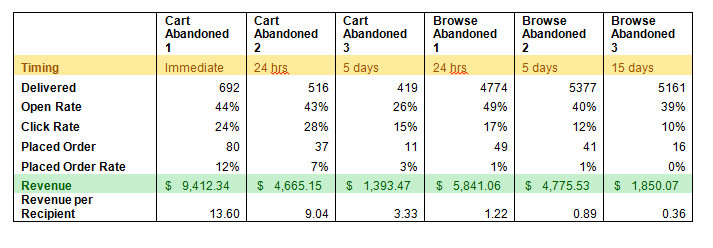
Cart and Browse visitor flow
Below is a flow chart of how Browse and Cart abandonment marketing can work hand-in-hand to engage with a prospect based on browsing and shopping behavior.
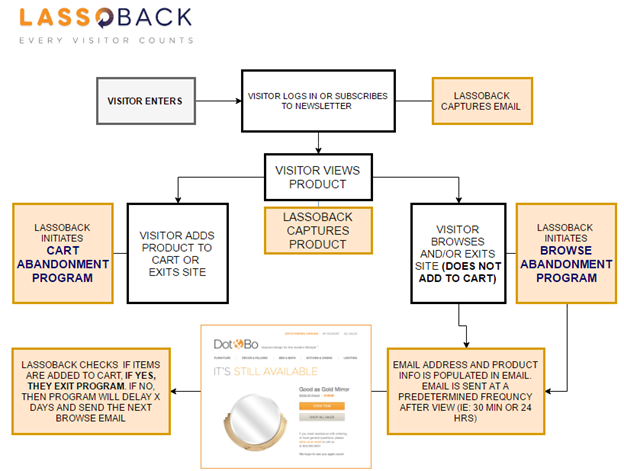
What if you don’t sell any products? (B2B)
Browse abandonment emails can also work well for B2B sites that are promoting event registration or offering white paper downloads. The goal here is not necessarily sell, but to further engage or generate a lead. For example, if a visitor looks at an event registration page and abandons, we can send timely campaigns to entice browsers to return and begin the registration process. If they abandon the registration form mid-way, we can further ask them to come back and also note which question was the stumbling block – this is also known as Form Abandonment – that’s a topic for another time.
The point is that any call-to-action on your web site can be an exit point and a campaign trigger to nudge a prospect back to reengage.
How Does it All Work?
Safe, secure and quick installation. Our cart and browse abandonment campaigns are enabled via javascript which doesn’t affect the performance of your website. We can implement browse code to specific pages with the appropriate exclusion rules. Once you give us access, we do the rest.
Please contact us if you want to learn more about our LassoBack Browse and Cart re-marketing products and services.
Examples of CA and BA email campaigns
